Yi-Cheng Lin
BreezyVoice: Adapting TTS for Taiwanese Mandarin with Enhanced Polyphone Disambiguation -- Challenges and Insights
Jan 29, 2025Abstract:We present BreezyVoice, a Text-to-Speech (TTS) system specifically adapted for Taiwanese Mandarin, highlighting phonetic control abilities to address the unique challenges of polyphone disambiguation in the language. Building upon CosyVoice, we incorporate a $S^{3}$ tokenizer, a large language model (LLM), an optimal-transport conditional flow matching model (OT-CFM), and a grapheme to phoneme prediction model, to generate realistic speech that closely mimics human utterances. Our evaluation demonstrates BreezyVoice's superior performance in both general and code-switching contexts, highlighting its robustness and effectiveness in generating high-fidelity speech. Additionally, we address the challenges of generalizability in modeling long-tail speakers and polyphone disambiguation. Our approach significantly enhances performance and offers valuable insights into the workings of neural codec TTS systems.
Building a Taiwanese Mandarin Spoken Language Model: A First Attempt
Nov 11, 2024



Abstract:This technical report presents our initial attempt to build a spoken large language model (LLM) for Taiwanese Mandarin, specifically tailored to enable real-time, speech-to-speech interaction in multi-turn conversations. Our end-to-end model incorporates a decoder-only transformer architecture and aims to achieve seamless interaction while preserving the conversational flow, including full-duplex capabilities allowing simultaneous speaking and listening. The paper also details the training process, including data preparation with synthesized dialogues and adjustments for real-time interaction. We also developed a platform to evaluate conversational fluency and response coherence in multi-turn dialogues. We hope the release of the report can contribute to the future development of spoken LLMs in Taiwanese Mandarin.
Dynamic-SUPERB Phase-2: A Collaboratively Expanding Benchmark for Measuring the Capabilities of Spoken Language Models with 180 Tasks
Nov 08, 2024



Abstract:Multimodal foundation models, such as Gemini and ChatGPT, have revolutionized human-machine interactions by seamlessly integrating various forms of data. Developing a universal spoken language model that comprehends a wide range of natural language instructions is critical for bridging communication gaps and facilitating more intuitive interactions. However, the absence of a comprehensive evaluation benchmark poses a significant challenge. We present Dynamic-SUPERB Phase-2, an open and evolving benchmark for the comprehensive evaluation of instruction-based universal speech models. Building upon the first generation, this second version incorporates 125 new tasks contributed collaboratively by the global research community, expanding the benchmark to a total of 180 tasks, making it the largest benchmark for speech and audio evaluation. While the first generation of Dynamic-SUPERB was limited to classification tasks, Dynamic-SUPERB Phase-2 broadens its evaluation capabilities by introducing a wide array of novel and diverse tasks, including regression and sequence generation, across speech, music, and environmental audio. Evaluation results indicate that none of the models performed well universally. SALMONN-13B excelled in English ASR, while WavLLM demonstrated high accuracy in emotion recognition, but current models still require further innovations to handle a broader range of tasks. We will soon open-source all task data and the evaluation pipeline.
Codec-SUPERB @ SLT 2024: A lightweight benchmark for neural audio codec models
Sep 21, 2024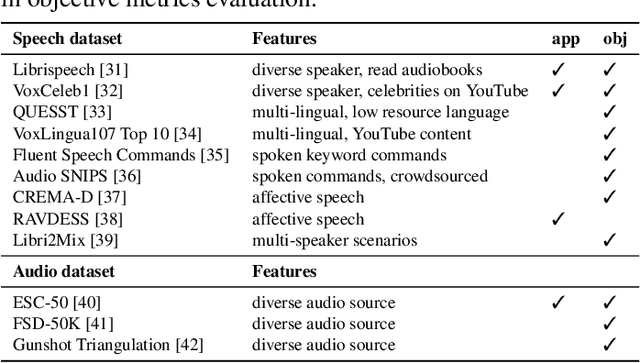
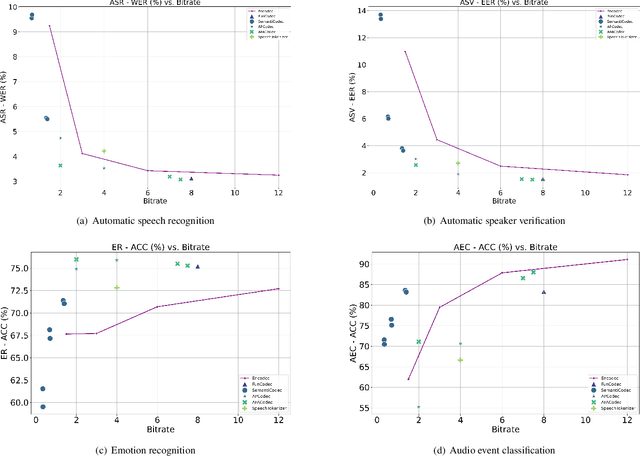
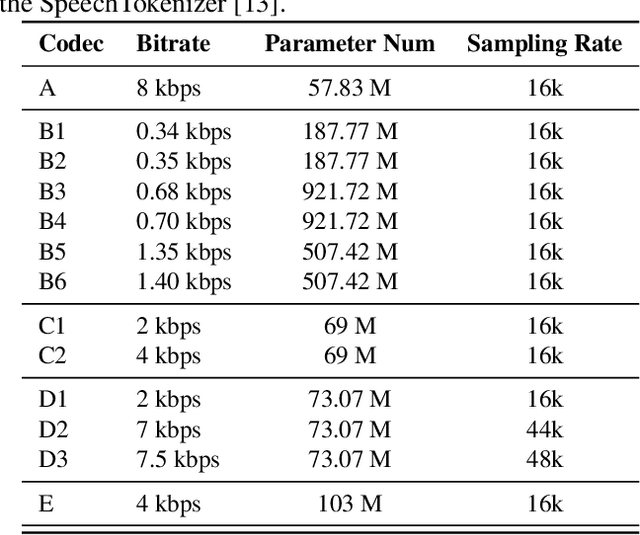
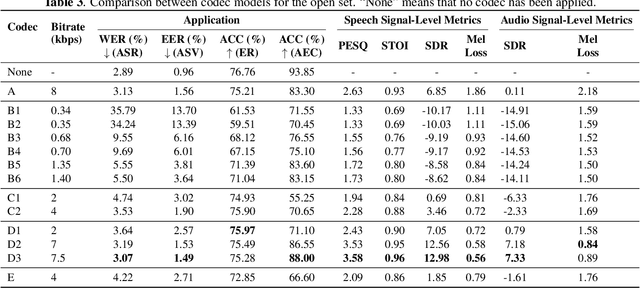
Abstract:Neural audio codec models are becoming increasingly important as they serve as tokenizers for audio, enabling efficient transmission or facilitating speech language modeling. The ideal neural audio codec should maintain content, paralinguistics, speaker characteristics, and audio information even at low bitrates. Recently, numerous advanced neural codec models have been proposed. However, codec models are often tested under varying experimental conditions. As a result, we introduce the Codec-SUPERB challenge at SLT 2024, designed to facilitate fair and lightweight comparisons among existing codec models and inspire advancements in the field. This challenge brings together representative speech applications and objective metrics, and carefully selects license-free datasets, sampling them into small sets to reduce evaluation computation costs. This paper presents the challenge's rules, datasets, five participant systems, results, and findings.
Improving Speech Emotion Recognition in Under-Resourced Languages via Speech-to-Speech Translation with Bootstrapping Data Selection
Sep 17, 2024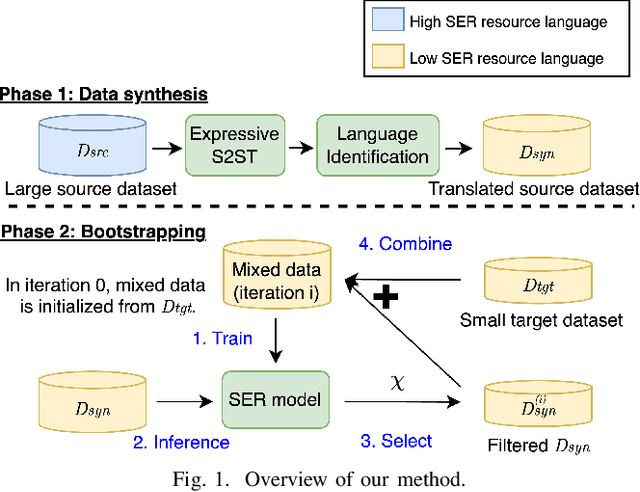
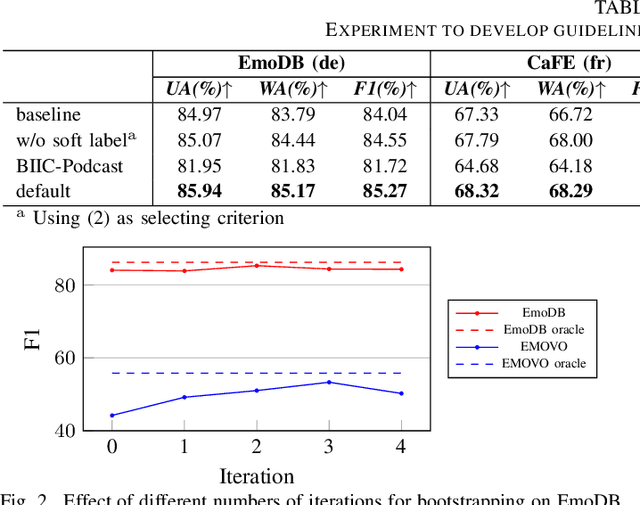


Abstract:Speech Emotion Recognition (SER) is a crucial component in developing general-purpose AI agents capable of natural human-computer interaction. However, building robust multilingual SER systems remains challenging due to the scarcity of labeled data in languages other than English and Chinese. In this paper, we propose an approach to enhance SER performance in low SER resource languages by leveraging data from high-resource languages. Specifically, we employ expressive Speech-to-Speech translation (S2ST) combined with a novel bootstrapping data selection pipeline to generate labeled data in the target language. Extensive experiments demonstrate that our method is both effective and generalizable across different upstream models and languages. Our results suggest that this approach can facilitate the development of more scalable and robust multilingual SER systems.
Leveraging Joint Spectral and Spatial Learning with MAMBA for Multichannel Speech Enhancement
Sep 16, 2024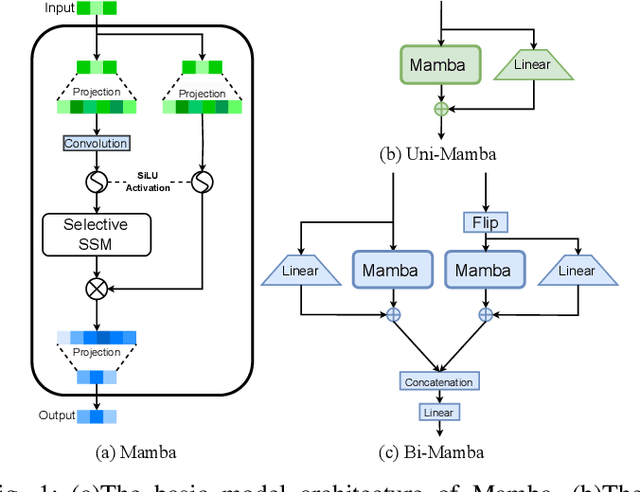

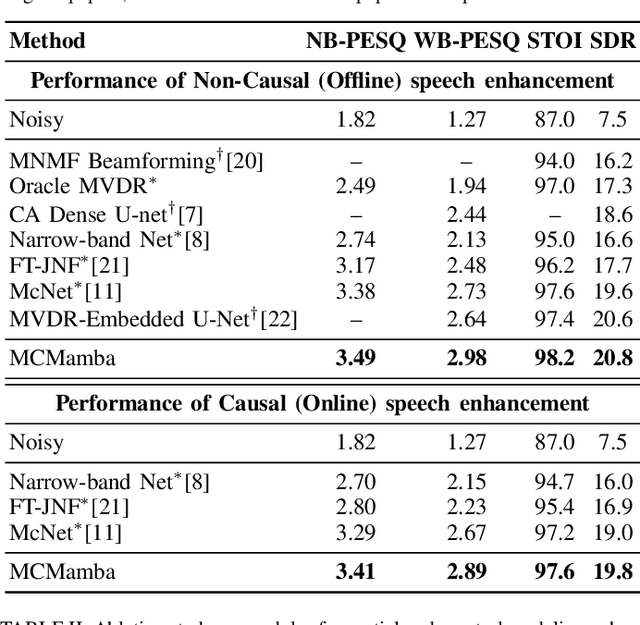

Abstract:In multichannel speech enhancement, effectively capturing spatial and spectral information across different microphones is crucial for noise reduction. Traditional methods, such as CNN or LSTM, attempt to model the temporal dynamics of full-band and sub-band spectral and spatial features. However, these approaches face limitations in fully modeling complex temporal dependencies, especially in dynamic acoustic environments. To overcome these challenges, we modify the current advanced model McNet by introducing an improved version of Mamba, a state-space model, and further propose MCMamba. MCMamba has been completely reengineered to integrate full-band and narrow-band spatial information with sub-band and full-band spectral features, providing a more comprehensive approach to modeling spatial and spectral information. Our experimental results demonstrate that MCMamba significantly improves the modeling of spatial and spectral features in multichannel speech enhancement, outperforming McNet and achieving state-of-the-art performance on the CHiME-3 dataset. Additionally, we find that Mamba performs exceptionally well in modeling spectral information.
Spoken Stereoset: On Evaluating Social Bias Toward Speaker in Speech Large Language Models
Aug 14, 2024Abstract:Warning: This paper may contain texts with uncomfortable content. Large Language Models (LLMs) have achieved remarkable performance in various tasks, including those involving multimodal data like speech. However, these models often exhibit biases due to the nature of their training data. Recently, more Speech Large Language Models (SLLMs) have emerged, underscoring the urgent need to address these biases. This study introduces Spoken Stereoset, a dataset specifically designed to evaluate social biases in SLLMs. By examining how different models respond to speech from diverse demographic groups, we aim to identify these biases. Our experiments reveal significant insights into their performance and bias levels. The findings indicate that while most models show minimal bias, some still exhibit slightly stereotypical or anti-stereotypical tendencies.
EMO-Codec: An In-Depth Look at Emotion Preservation capacity of Legacy and Neural Codec Models With Subjective and Objective Evaluations
Jul 30, 2024



Abstract:The neural codec model reduces speech data transmission delay and serves as the foundational tokenizer for speech language models (speech LMs). Preserving emotional information in codecs is crucial for effective communication and context understanding. However, there is a lack of studies on emotion loss in existing codecs. This paper evaluates neural and legacy codecs using subjective and objective methods on emotion datasets like IEMOCAP. Our study identifies which codecs best preserve emotional information under various bitrate scenarios. We found that training codec models with both English and Chinese data had limited success in retaining emotional information in Chinese. Additionally, resynthesizing speech through these codecs degrades the performance of speech emotion recognition (SER), particularly for emotions like sadness, depression, fear, and disgust. Human listening tests confirmed these findings. This work guides future speech technology developments to ensure new codecs maintain the integrity of emotional information in speech.
EMO-Codec: A Depth Look at Emotion Preservation Capacity of Legacy and Neural Codec Models With Subjective and Objective Evaluations
Jul 24, 2024



Abstract:The neural codec model reduces speech data transmission delay and serves as the foundational tokenizer for speech language models (speech LMs). Preserving emotional information in codecs is crucial for effective communication and context understanding. However, there is a lack of studies on emotion loss in existing codecs. This paper evaluates neural and legacy codecs using subjective and objective methods on emotion datasets like IEMOCAP. Our study identifies which codecs best preserve emotional information under various bitrate scenarios. We found that training codec models with both English and Chinese data had limited success in retaining emotional information in Chinese. Additionally, resynthesizing speech through these codecs degrades the performance of speech emotion recognition (SER), particularly for emotions like sadness, depression, fear, and disgust. Human listening tests confirmed these findings. This work guides future speech technology developments to ensure new codecs maintain the integrity of emotional information in speech.
Listen and Speak Fairly: A Study on Semantic Gender Bias in Speech Integrated Large Language Models
Jul 09, 2024Abstract:Speech Integrated Large Language Models (SILLMs) combine large language models with speech perception to perform diverse tasks, such as emotion recognition to speaker verification, demonstrating universal audio understanding capability. However, these models may amplify biases present in training data, potentially leading to biased access to information for marginalized groups. This work introduces a curated spoken bias evaluation toolkit and corresponding dataset. We evaluate gender bias in SILLMs across four semantic-related tasks: speech-to-text translation (STT), spoken coreference resolution (SCR), spoken sentence continuation (SSC), and spoken question answering (SQA). Our analysis reveals that bias levels are language-dependent and vary with different evaluation methods. Our findings emphasize the necessity of employing multiple approaches to comprehensively assess biases in SILLMs, providing insights for developing fairer SILLM systems.
 Add to Chrome
Add to Chrome Add to Firefox
Add to Firefox Add to Edge
Add to Edge